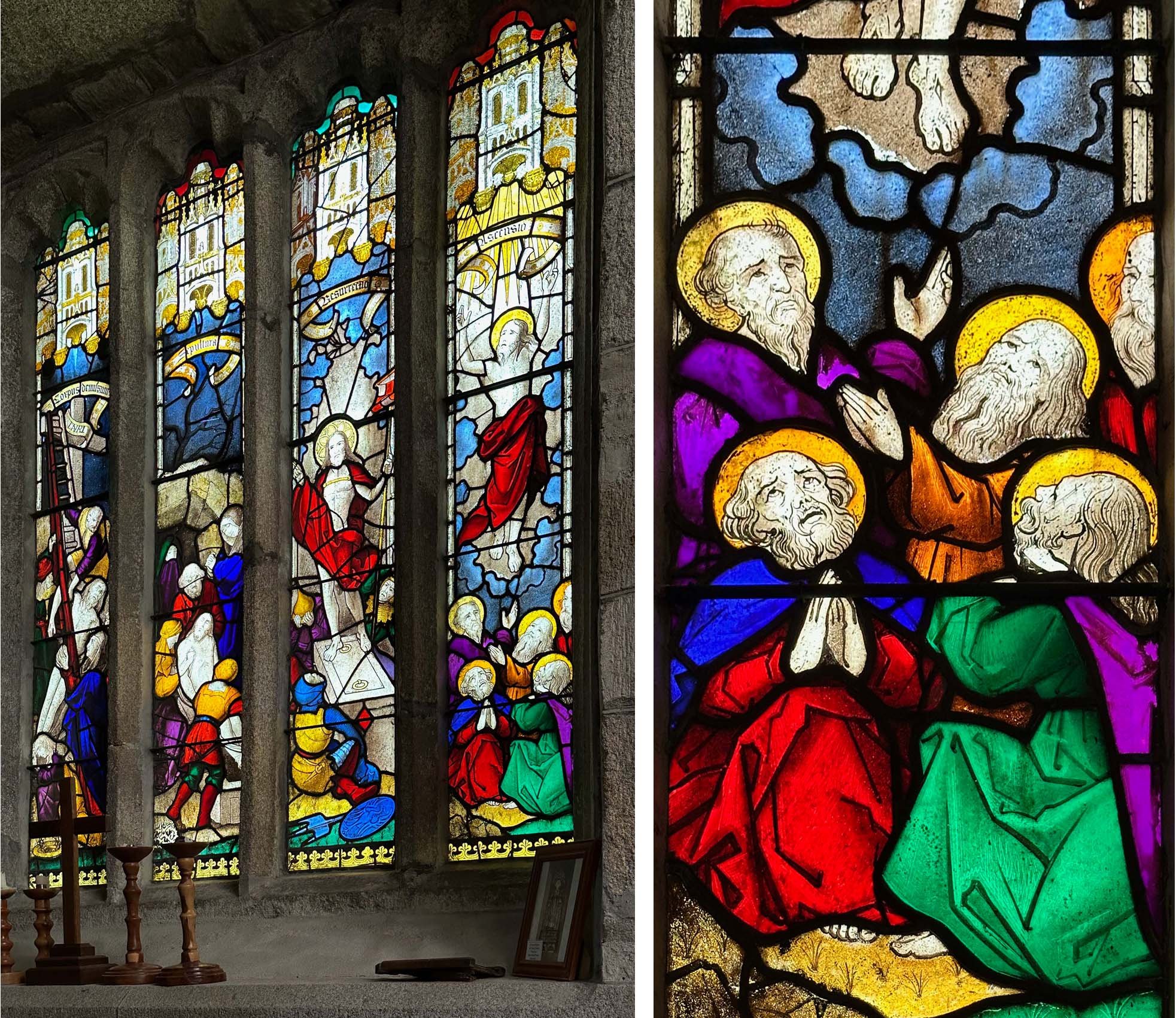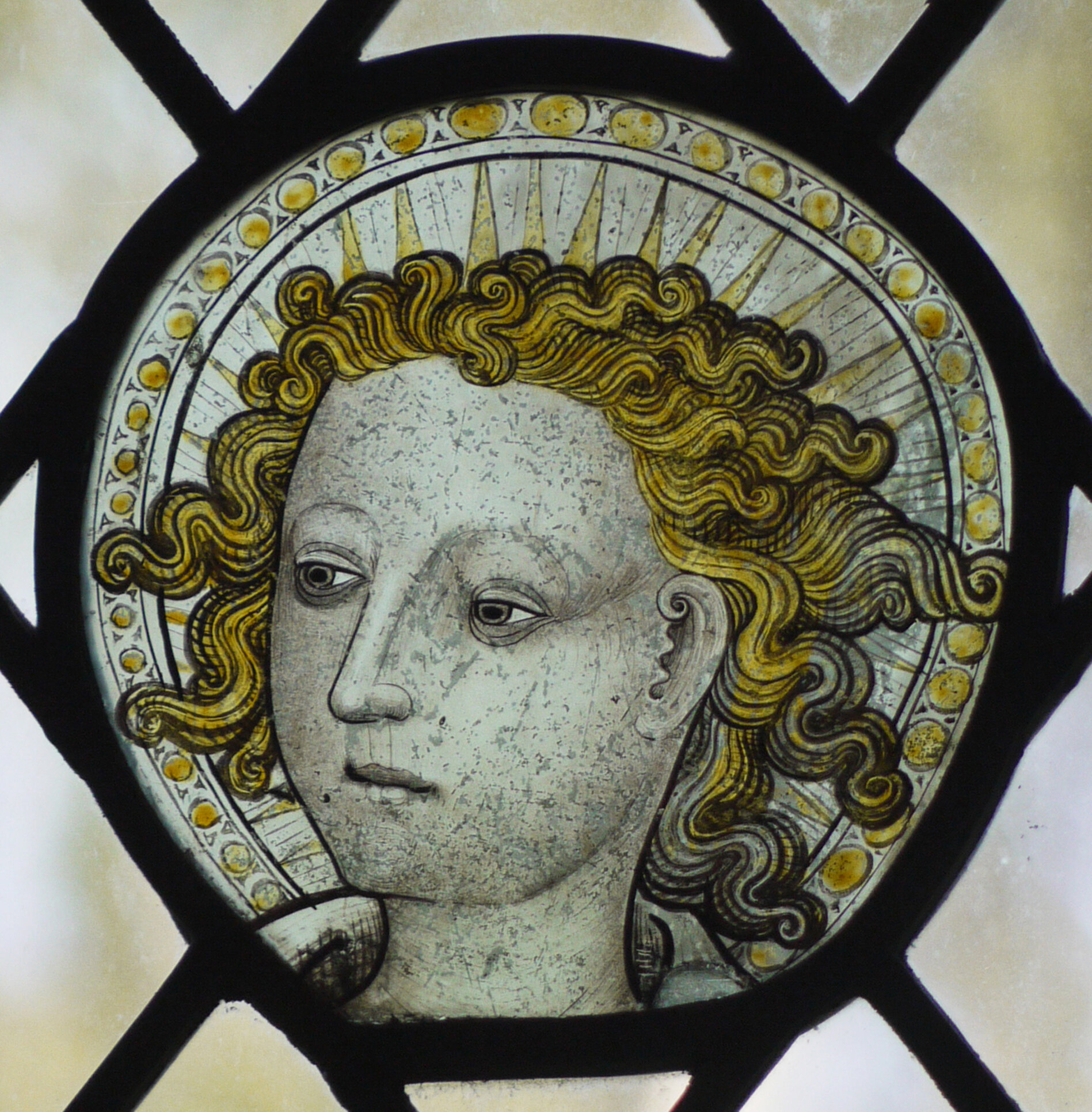Left: St Neot, south porch. Right: Interior, looking east.
Welcome to our ancient parish church in the village of St Neot, nestling on the southern edge of Bodmin Moor. You have probably come to view our magnificent late medieval stained glass, the most complete set of parish church windows after Fairford in Gloucestershire are the opening words of the church guidebook, which goes on to describe the church as a magnificent example of what can be achieved with intractable granite. Although the visitor is urged to look around at other objects of historical interest, I had eyes only for the glass. Every window is filled with stained glass, not all of it in its original position but all of it heavily restored by John Hedgeland in the 1820s. In my account of the windows I have started in the south east corner with the Creation window then circled clockwise around to Hedgeland’s Last Supper window behind the altar.
Left: South east corner with Creation and Noah windows. Right: Top of Creation window.
Left: Creation window detail, Death of Adam. Right: Bottom of Creation window.
The Creation window retains 95% of its original 1480s glass. In its tracery (above right) is a set of the nine orders of angels, the panels below show the early history of the world from God marking out the sun in the sky with a pair of compasses at top left to God commanding Noah to make the Ark at bottom right. The detail above shows the death of Adam, with his son Seth putting pips from the Tree of Life under his tongue.
It’s obvious that the next window, the story of Noah, has sections by Hedgeland - look at that light blue glass - the tracery lights and most of the scenes in the bottom row are replacements. The Ark, shown in the detail below (c.1480) is a fifteenth century sailing boat with Noah, his wife and pairs of animals inside while the dove and the raven fly away.
Left: Noah window detail, Noah and his wife on the Ark. Right: Noah window.
Row of windows along the south aisle.
It is remarkable that so much of this fifteenth and sixteenth century glass has survived the vandalism that took out a lot of the stained glass in English churches. The suggested reason for this is that most of the windows depict saints chosen by private donors with their families commemorated below, thereby representing local pride and an interest in keeping the windows safe. Those in the south aisle are named for the donor families - Borlase, Martyn, Mutton, Callaway and Tubbe (above). The last two of these windows are not in their original positions, similarly some of the donor panels that would have been on the north side of the church and therefore with the donors facing the altar. A row of these lovely little figures with interesting backgrounds and a request for the saint to pray for them is shown below.
Details of donor panels from the bottom of the south aisle windows.
Left & Centre: details of St George’s window, he is torn with rakes, he is thrown into a cauldron of molten lead. Right: St George’s window.
I’ve missed out a couple of later windows at the west end of the church, before coming to the north west corner with windows depicting the Saints George and Neot in sequences of scenes from their lives. The St George window (above) dated from 1500 to 1510 has episodes in his life not seen elsewhere; in scenes 7 to 11 he is tortured in different ways before being beheaded in the final panel.
Left: North aisle. Right, St Neot window.
Like all the windows in the slightly later north aisle, the St Neot window has a plainer shape with straight tops. The story telling in this glass, dated 1530 and given by the young men of the parish, is wonderfully simple and repetitive, strip cartoon style, with a consistent castellated background. It seems to me the most legible of the windows, with the Hedgeland additions blending in to the colour scheme. The last scene shows St Neot on a visit to Rome being blessed by the Pope, said to be Marinus (882 - 884). There is some confusion about St Neot as the stories about a Cornish hermit and a Saxon saint were mixed together after the Cornish St Neot’s bones were taken to Huntingdonshire following the Saxon conquest of Cornwall, only the right arm remains in the sepulchre in this church.
Lower half of St Neot window. In panels 5 to 8 Neot is lying in bed, his servant Barius cooks fish from the well, then throws them back where they return to life. In panels 9 to 11 a robber steals Neot’s cattle, stags come voluntarily to take their place before the robber repents and returns the stolen oxen.
Row of windows in north aisle.
The next three windows return to the scheme of saints and donors and are named for the donors - Young Women’s, Wives’ and Harry’s. They present a consistent row of ordered proportion and tone, with a series of richly coloured gowns at the bottom of the first two windows and patterned settings for the Harry family in the third.
Details of donor panels from the bottom of the north aisle windows.
Left: Redemption window. Right, detail of Redemption window.
The three last windows in my sequence, Redemption, Acts and the Last Supper were designed by John Hedgeland, the latter based on a German woodcut of 1491 that he found in the British Museum. Redemption and Acts were moved from the south aisle and are now rather hidden behind the organ in the vestry, while the Last Supper window in the chancel has itself been recently restored and includes original glass in the tracery. These are all interesting windows with shapes in the bands of lettering and the canopies and a colour balance that ties them in to the rest of the windows in the church. The painting of the figures is free and lively, the work of the skilled glass painter James Henry Nixon who worked with Benjamin Baillie and John Hedgeland on this complete restoration scheme.
I am indebted to the facsimile copy of a 1937 guide to the windows by G. McN. Rushforth which gives thorough descriptions of each panel and an account of what used to be where that I bought in the church alongside the afore mentioned church guidebook.
Left: North east corner of the church with Acts window. Right: Last Supper window.






































